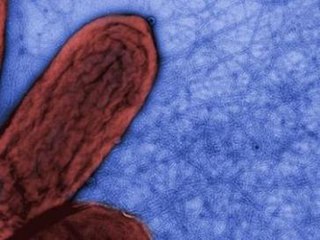Related Research Articles
Methanotrophs are prokaryotes that metabolize methane as their source of carbon and chemical energy. They are bacteria or archaea, can grow aerobically or anaerobically, and require single-carbon compounds to survive.
In biology, syntrophy, synthrophy, or cross-feeding is the phenomenon of one species feeding on the metabolic products of another species to cope up with the energy limitations by electron transfer. In this type of biological interaction, metabolite transfer happens between two or more metabolically diverse microbial species that live in close proximity to each other. The growth of one partner depends on the nutrients, growth factors, or substrates provided by the other partner. Thus, syntrophism can be considered as an obligatory interdependency and a mutualistic metabolism between two different bacterial species.
Oxalobacter formigenes is a Gram negative oxalate-degrading anaerobic bacterium that was first isolated from the gastrointestinal tract of a sheep in 1985. To date, the bacterium has been found to colonize the large intestines of numerous vertebrates, including humans, and has even been isolated from freshwater sediment. It processes oxalate by decarboxylation into formate, producing energy for itself in the process.
Desulfobacter hydrogenophilus is a strictly anaerobic sulfate-reducing bacterium. It was isolated and characterized in 1987 by Friedrich Widdel of the University of Konstanz (Germany). Like most sulfate-reducing bacteria (SRB), D. hydrogenophilus is capable of completely oxidizing organic compounds (specifically acetate, pyruvate and ethanol) to CO2, and therefore plays a key role in biomineralization in anaerobic marine environments. However, unlike many SRB, D. hydrogenophilus is a facultative lithoautotroph, and can grow using H2 as an electron donor and CO2 as a carbon source. D. hydrogenophilus is also unique because it is psychrophilic (and has been shown to grow at temperatures as low as 0 °C or 32 °F). It is also diazotrophic, or capable of fixing nitrogen.

Geobacter sulfurreducens is a gram-negative metal and sulphur-reducing proteobacterium. It is rod-shaped, aerotolerant anaerobe, non-fermentative, has flagellum and type four pili, and is closely related to Geobacter metallireducens. Geobacter sulfurreducens is an anaerobic species of bacteria that comes from the family of bacteria called Geobacteraceae. Under the genus of Geobacter, G. sulfurreducens is one out of twenty different species. The Geobacter genus was discovered by Derek R. Lovley in 1987. G. sulfurreducens was first isolated in Norman, Oklahoma, USA from materials found around the surface of a contaminated ditch.
Desulfomonile tiedjei is a bacterium. It is anaerobic, dehalogenating, sulfate-reducing, Gram-negative, non-motile, non-spore-forming and rod-shaped. Its type strain is DCB-1.
Thermacetogenium phaeum is a bacterium, the type species of its genus. It is strictly anaerobic, thermophilic, syntrophic and acetate-oxidizing. Its cells are gram-positive, endospore-forming and rod-shaped. Its type strain is PBT. It has a potential biotechnological role.
Syntrophomonas sapovorans is a bacterium. It is anaerobic, syntrophic, and fatty acid-oxidizing and obligately proton-reducing. Its type strain is OM. It has a doubling time of 40 hours. It is part of the family Syntrophomonadaceae based on comparative small-subunit (SSU) rRNA sequence analysis. This family currently contains three genera, Syntrophomonas, Syntrophospora, and Thermosyntropha, as well as two closely related isolates, strains FSM2 and FSS7.
Syntrophomonas curvata is a bacterium. It is anaerobic, syntrophic and fatty acid-oxidizing. Its type strain is GB8-1T.
Syntrophomonas palmitatica is a bacterium. It is anaerobic, syntrophic and fatty acid-oxidizing. Its type strain is GB8-1T. Cells are slightly curved, non-motile rods.
Syntrophomonas zehnderi is a bacterium. It is anaerobic, syntrophic and fatty acid-oxidizing. The type strain is OL-4T. Cells are slightly curved, non-motile rods.
Syntrophobacter fumaroxidans is a species of syntrophic propionate-degrading sulfate-reducing bacterium. Strain MPOBT is the type strain. Its genome has been fully sequenced.

"Syntrophothermus lipocalidus" is a bacterium, the type species and only currently described species in its genus. It is thermophilic, syntrophic, fatty-acid-oxidizing and anaerobic, and utilises isobutyrate. TGB-C1T is its type strain. Its genome has been fully sequenced.
Bacillus mojavensis is a bacterium. Bacillus axarquiensis and Bacillus malacitensis are considered later heterotypic synonyms of B. mojavensis. It is named after the Mojave Desert.
Pelotomaculum thermopropionicum is an anaerobic, thermophilic, syntrophic propionate-oxidizing bacterium, the type species of its genus. The type strain is strain SI(T).
Syntrophus aciditrophicus is a gram-negative and rod-shaped bacterium. It is non-motile, non-spore-forming and grows under strictly anaerobic conditions, thus an obligate anaerobe. It degrades fatty acids and benzoate in syntrophic association with hydrogen-using microorganisms. Its genome was published in 2007.
Smithella propionica is a species of bacteria, the type species of its genus. It is anaerobic, syntrophic, propionate-oxidizing bacteria, with type strain LYPT.
Thermosyntropha lipolytica is a lipolytic, anaerobic, alkalitolerant, thermophilic bacteria. It lives in syntrophic coculture with a methanogen. Its cells are non-motile, non-spore forming, straight or slightly curved rods. Its type strain is JW/VS-265T.
Thermosinus carboxydivorans is an anaerobic, thermophilic, Gram-negative, carbon-monoxide-oxidizing, hydrogenogenic bacterium, the type species of its genus. It is facultatively carboxydotrophic, curved, motile, rod-shaped, with a length of 2.6–3 μm, a width of about 0.5 μm and lateral flagellation. Its type strain is Nor1T.
Oxalobacter aliiformigenes is a Gram negative, non-spore-forming, oxalate-degrading anaerobic bacterium that was first isolated from human fecal samples. O. aliiformigenes is believed to have roles in calcium oxalate kidney stone disease because of its unique ability to utilize oxalate as its primary carbon source.
References
- ↑ McInerney MJ, Bryant MP, Hespell RB, Costerton JW (April 1981). "Syntrophomonas wolfei gen. nov. sp. nov., an Anaerobic, Syntrophic, Fatty Acid-Oxidizing Bacterium". Applied and Environmental Microbiology . 41 (4): 1029–39. doi:10.1128/AEM.41.4.1029-1039.1981. PMC 243852 . PMID 16345745.